I went for a routine dental checkup – then was diagnosed with mouth cancer and had half my tongue cut out
A model has shared her ordeal after a routine dentist appointment sparked her deadly battle with cancer.
Elizabeth Brown Lax, now 45 and from Henderson, Nevada, said her dentist “checked my tongue as usual and felt a lump.”
She was diagnosed with stage one oral squamous cell carcinoma, which is normally harmless, and had a small piece of her tongue cut out.
But a year later, when ‘excruciating’ pain broke out in her ear, doctors said the cancer had returned and was now in stage three, meaning it had spread to her lymph nodes.
She was sent for a 12-hour procedure in which doctors cut away half her tongue and part of her jaw before rebuilding them with tissue and bone from her leg – an operation that left her face swelling.
Elizabeth Brown Lax, now 45 and from Nevada, was diagnosed with oral cancer after doctors discovered a lump on her tongue. She is pictured above after surgery
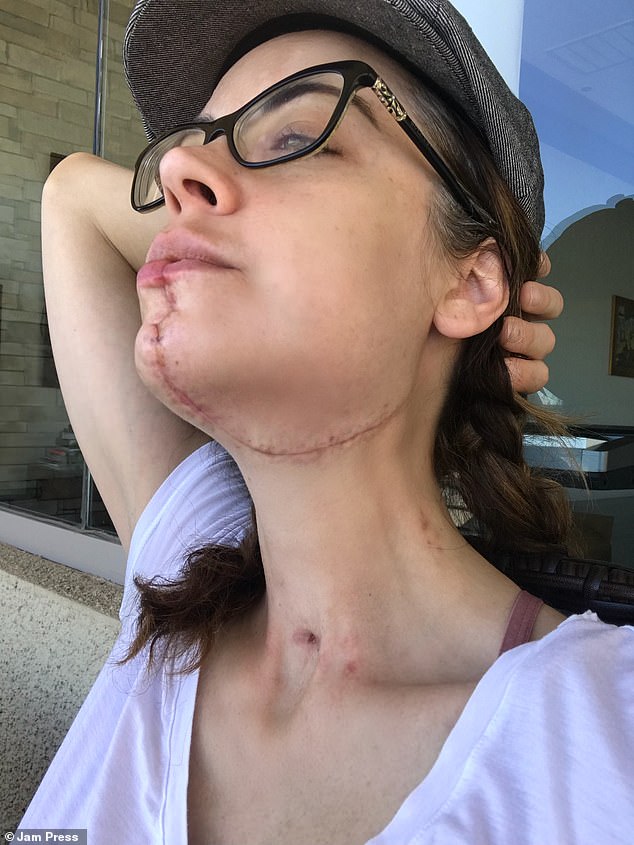
The cancer was initially stage one and was removed with minor surgery. But a year later it had returned and was stage three, meaning it had spread to the lymph nodes near the tongue. Ms Lax had half her tongue and parts of her jaw removed to treat the cancer. She is pictured after surgery with the scar on her face
Ms Lax has now recovered and the cancer has not returned, and she has returned to media work in production.
The singer and on-camera host, also known as Elly, also has lichen planus, a condition in which the immune system attacks the skin, causing purplish, flat and itchy bumps or lesions to appear.
The condition is uncommon and affects about one to two percent of Americans, who are typically between the ages of 30 and 60.
But patients who have it are sent for regular oral checkups to check for lesions in their mouth and any cancers that may develop.
Lichen planus may increase the risk of oral cancer in the long term due to the persistent inflammation.
Oral squamous cell carcinoma is diagnosed in approximately 54,000 adults each year – and the risk is more than twice as high in men as in women.
According to the American Cancer Society, approximately 70 percent of those diagnosed with cancer live more than five years after their diagnosis.
The five-year survival rate is as high as 84 percent for those whose cancer is diagnosed early, but drops to 41 percent when the cancer is only discovered after it has spread to other parts of the body.
When Ms Lax was diagnosed in 2017 at the age of 39, she said: ‘My oral surgeon checked my tongue as usual and felt a lump.’
“He actually said, ‘That doesn’t look nice.’ That’s not exactly what you want to hear from your oral surgeon, but my lichen planus had been getting worse for years.
‘He took a biopsy and it was positive for cancer; squamous cell carcinoma.’
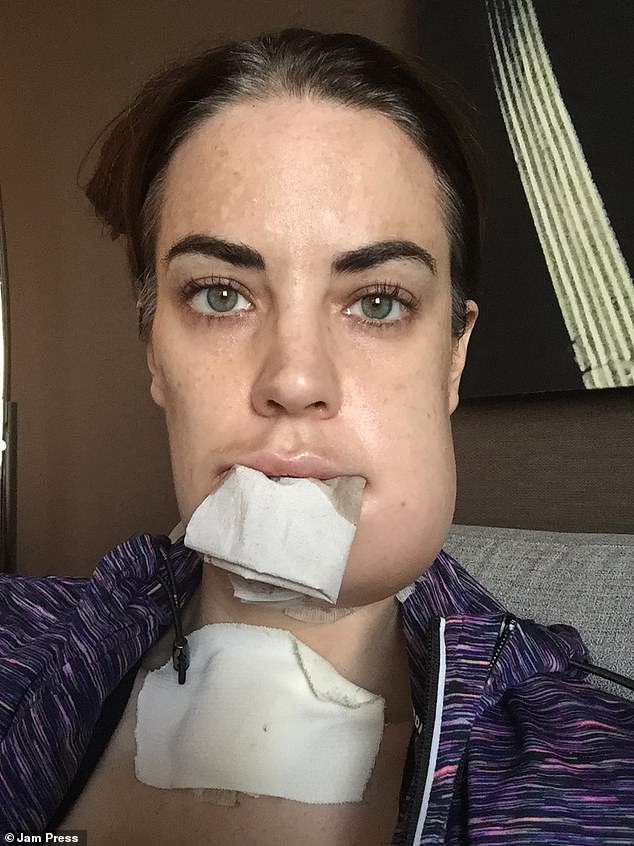
Ms. Lax didn’t look in the mirror for a few days after the operation, she said, but when she did, she described the lump as looking like a volleyball.
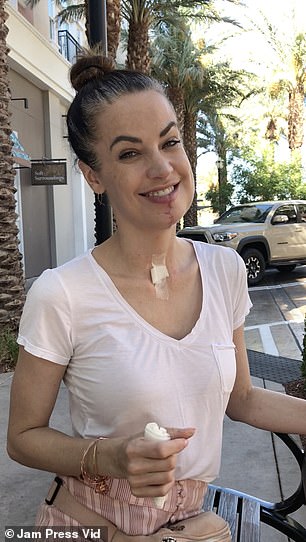
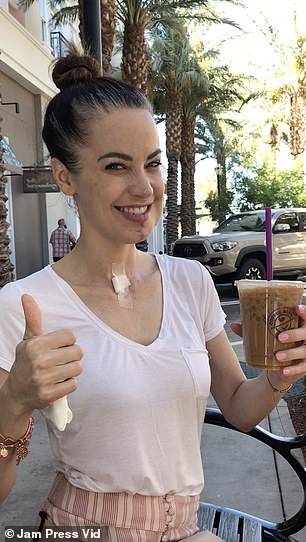
She also had a tracheostomy, which opened a hole in her neck (pictured) so she could eat and breathe until her mouth healed.

Ma Lax is pictured above after surgery. The scar is visible through her lip and down to her chin
She added: ‘No one can fully prepare you for being told you have cancer. For about a week I couldn’t eat, sleep or concentrate.’
“I remember going to my regular hair appointment and being on the verge of tears, worried that all my hair would fall out anyway (even though I hadn’t had chemotherapy yet).”
Doctors removed the lump with minor surgery, but were unable to perform radiotherapy because of her lichen planus.
But a year later she developed pain in her ear, which quickly became ‘unbearable’, leading doctors to determine that the cancer had returned.
“I went back and demanded to be re-scanned and re-biopsy’d,” she said, “and it turned out the cancer had returned and it was stage three.”
‘I remember my surgeons telling me what they had to do with my body to save me.
‘They said I needed a hemiglossectomy, where half of my tongue was removed, and a mandibulectomy, where my jaw bone was replaced with bone from my leg.
‘I would also need a tracheostomy so I could breathe in hospital, and a feeding tube for five months.
“And I would have a big scar running from my lip, down my chin and around my jaw.”
In a tracheostomy, doctors make a small hole at the base of the neck, connected to the trachea, or trachea, so a person can breathe and eat without using their mouth.
In May 2018, Ms Lax underwent the 12-hour operations, which also included rebuilding her tongue and jaw flap using tissue from her leg.
She said: ‘My plastic surgeon and her team were very compassionate and did their best to preserve the natural shape of my face.
‘Not an easy task!
‘After the tumor was removed, they removed the necessary tissue from my leg and reconstructed my face.
‘I was in hospital for about nine days recovering, with drains all over my body that came loose over time.’

Ms Lax, who is also a singer and on-camera host, is pictured above after the operation
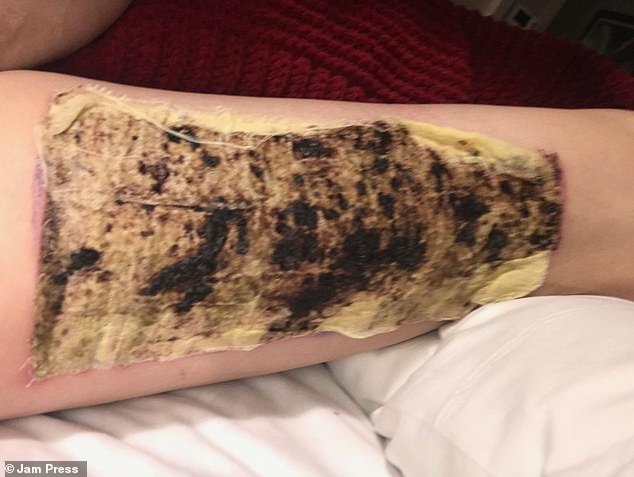
Doctors rebuilt her jaw and tongue using tissue grafted from her leg (pictured)

The scar from her tracheostomy is pictured above

Ms. Lax is pictured above with her boyfriend


She said she was very pleased with the doctors’ work to preserve her facial features as much as possible
A few days after the operation, she decided to look in the mirror.
“I didn’t look in the mirror for the first few days,” she said. ‘But when I finally did, I remember being in awe of everything they had done to save my life.
‘The left side of my face was the size of a volleyball. The stitches were fresh and deep.
“Nobody wants to look in the mirror and see so much physical trauma, but I knew how lucky I was to be alive.”
She then received chemotherapy and radiation and had to learn to walk again due to the operation on her leg.
She said: ‘I had to take everything one day at a time.
‘The feeding tube was rough and getting sick from chemo was horrible.
‘But friends and family came to me and we made the best of it.
“My family did everything they could to help me, including driving me to the dog park in my wheelchair so I could play with dogs.”
In 2020, Ms. Lax also underwent surgery to treat the scar on her face.
She now has a scan every year to check she is free of mouth cancer and the scans have been clear ever since.
In the years since her diagnosis, Ms. Lax has also found a new career path, serving as vice president of production at Network Media.
She added: ‘Thankfully, I have been free of oral cancer since my aggressive treatment five years ago.
‘These days I feel great and full of gratitude.
‘I am healthy and can do everything I could not do during my treatment: breathing independently, walking and exercising, chewing and swallowing, speaking and singing.
‘It is also my deepest hope that anyone who hears my story will help spread the message about this type of cancer, and encourage their friends and family to get early treatment for any strange symptoms.’
